Philips PML 9009 is the manufacturer's top LCD television, using Mini LED backlighting. The device itself boasts excellent build quality, a stylish remote control, and the manufacturer's exclusive multicoloured Ambilight backlighting. In terms of picture quality, a slight drawback can be noted with the blacks and contrast, which, to be frank, are not among the best and will not deliver as deep and vibrant an image as is found in televisions in a similar price range. However, it is worth noting that due to good algorithms responsible for the picture, its tonal quality was very satisfying. Therefore, the relatively low brightness of the display is well masked here, and with the implementation of Dolby Vision technology, it allows for access to HDR materials. What definitely deserves attention is the fluidity of transitions, which were quite outstanding and better than in some significantly more expensive units. The greatest advantage of this television is its performance in gaming. No negative remarks can be made in this aspect, as the television truly shines and will certainly satisfy any user. The motion smoothing system is also one of the aspects worth praising the television for. With two sliders, whose effects are perceptible at every position, each user can find the best level of smoothing for themselves. Therefore, it can confidently be said that when choosing a television for sports, PML9009 Philips can be identified as an excellent candidate. Although the TitanOS operating system is currently in the development phase and lacks a considerable number of applications, we do not believe that the manufacturer will do nothing in this regard.
- Matching (Score)
- Our verdict
- TV appearance
- Where to buy
- Contrast and black detail
- HDR effect quality
- Factory color reproduction
- Color reproduction after calibration
- Smoothness of tonal transitions
- Image scaling and smoothness of tonal transitions
- Blur and motion smoothness
- Console compatibility and gaming features
- Input lag
- Compatibility with PC
- Viewing angles
- TV efficiency during daytime
- Details about the matrix
- TV features
- Apps
- Playing files from USB
- Sound
Philips PML9009 / 9019 / 9059 vs Philips PUS8500
Direct compare
The Xtra / PML9019 / PML9059 / PML9009 / PML9049 / AMBILIGHT TV
PUS8500 / PUS8560 / PUS8510 / PUS8600

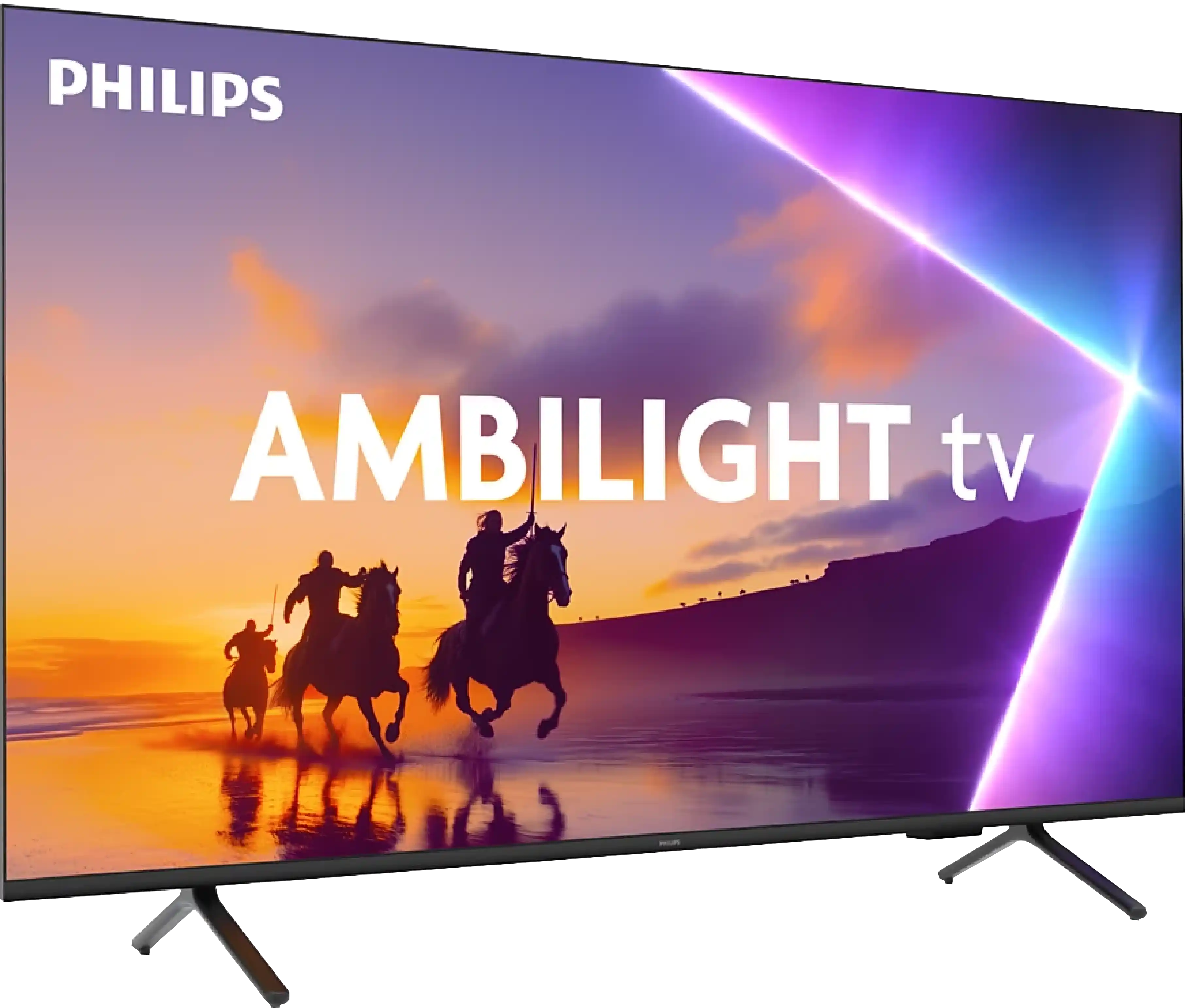
Panel type: LCD VA
Resolution: 3840x2160
System: Titan OS
Model year: 2024
Complete the survey to find out the result

Panel type: LCD VA
Resolution: 3840x2160
System: Titan OS
Model year: 2025
Complete the survey to find out the result

Overall rating
6.8
5.6
Movies and series in UHD quality
6.5
5.6
Classic TV, YouTube
6.3
6.2
Sports broadcasts (TV and apps)
6.6
5.2
Gaming on console
8.5
6.7
TV as a computer monitor
8.6
5.6
Watching in bright light
6.1
4.9
Utility functions
6.1
4.8
Apps
6.2
4.6
Sound quality
6.7
6.2
Complete the survey to find out what fits your preferences
Advantages
Very good tonal range of scenes exceeding the capabilities of the television
Well-functioning dynamic tone mapping feature
Colour reproduction after calibration
Performance after connecting to a console/PC
Ambilight System
High native contrast - VA panel
Low input lag
Basic gaming features: ALLM and VRR
Full support for audio formats: Dolby Atmos and DTS
Backlit remote control with numeric keypad
Disadvantages
Considerable halo/bloom effect
Poor viewing angles
The TitanOs system is not as advanced as the competition
Average contrast and black levels
Average panel brightness
The TitanOS system seems unfinished (some features do not work, missing applications)
Infrared remote control
Issues with font readability (PC)
Our verdict
Ambilight, as this is what we need to start with, is the biggest reason why it's worth buying the PUS8500. The three-sided backlighting of the television looks fantastic, especially in the evening. It creates an atmosphere, masks contrast shortcomings, and makes watching a film simply more enjoyable. Even if the black levels aren't perfect, the native VA panel offers decent performance at high contrast. Additionally, there’s quite a good input lag and several features for gamers such as ALLM and VRR. Although HDMI 2.1 and a 120Hz panel are absent, playing casually should be a pleasure. Especially since it feels responsive and without delays. Let’s also mention the full support for audio formats – both Dolby Atmos and DTS are included, so soundbar owners can also rejoice.
However, we won't sugarcoat it – this is still a budget television, and at times it’s clearly evident. The brightness is average – not weak enough to prevent viewing, but on an exceptionally sunny day, watching without curtains can be problematic. Nevertheless, in our opinion, the biggest disappointment of the PUS8560 is the Titan OS operating system. Despite the fact that the system debuted some time ago, certain functions simply refused to work – for instance, screen mirroring from a phone despite the manufacturer claiming that such a feature is present. There are fewer apps than in the competition, and the system itself operates rather clumsily. Generally, while it does have some features, it evidently lacks refinement.
Of course, this isn’t a television meant to compete with top models. But if someone is looking for something simple, with a great atmosphere provided by the Ambilight system, it is quite a fair proposition. You just have to know what to expect and accept the numerous compromises present here.
TV appearance




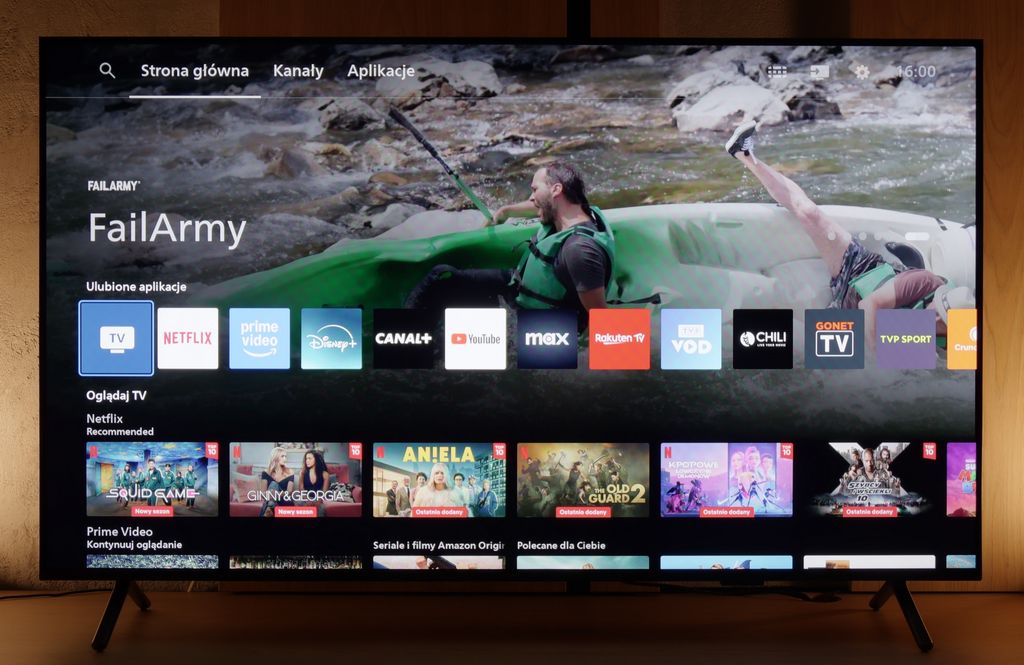
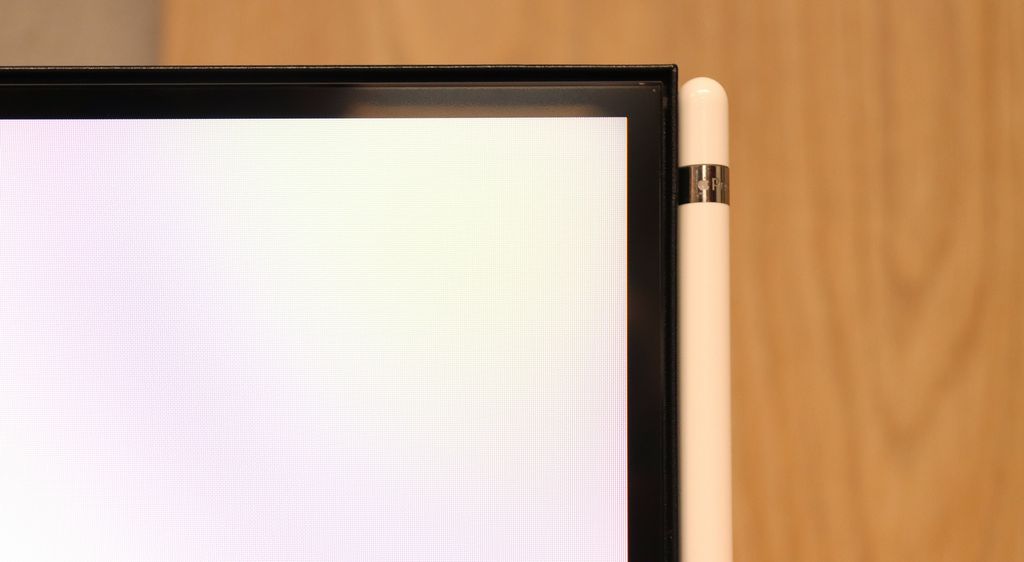
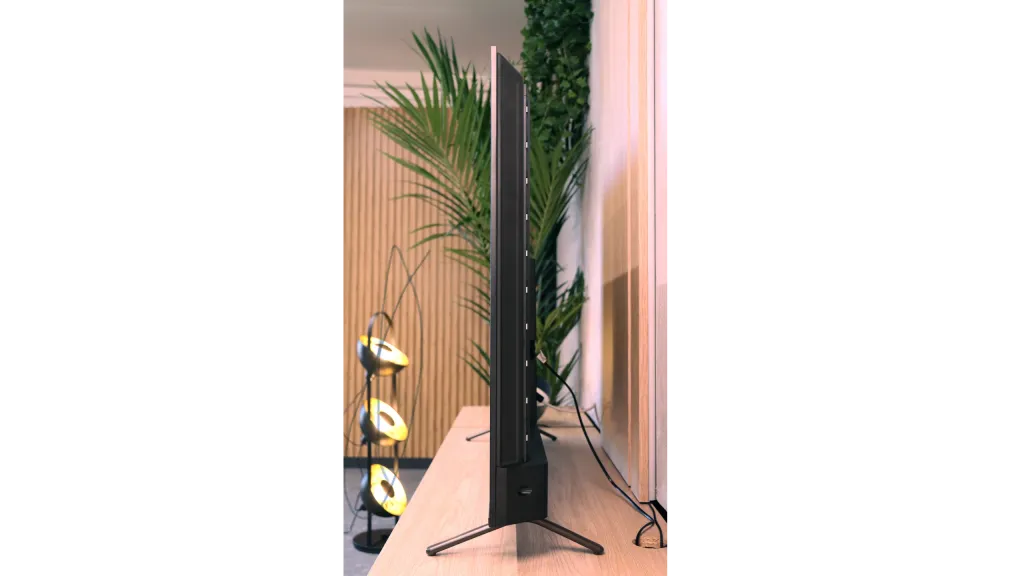
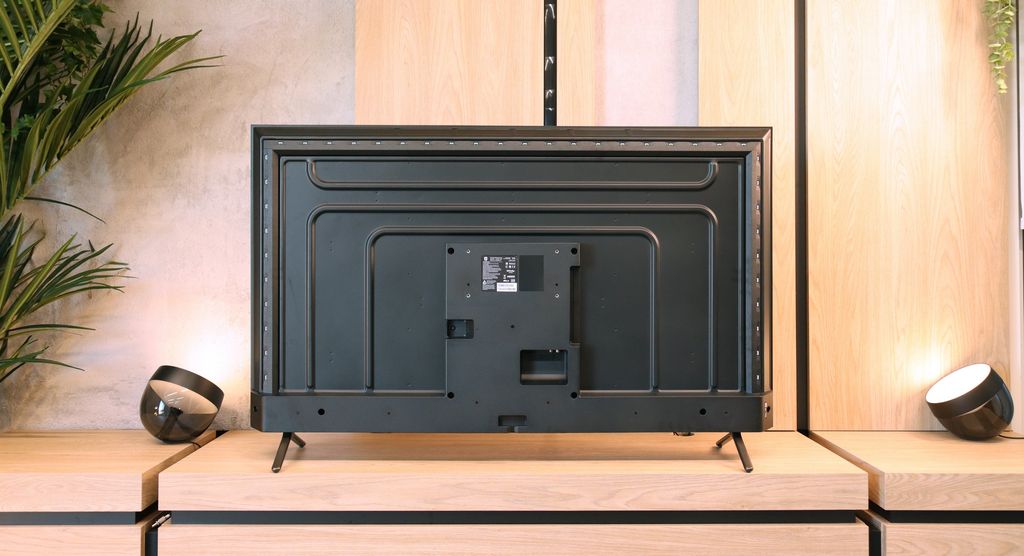
Contrast and black detail
6.6/10
6.1/10
Local dimming function: Yes, number of zones: 75 (15 x 5)
Local dimming function: No
Contrast:

Result
132,000:1

Result
16,550:1

Result
14,450:1

Result
7,850:1

Result
6,650:1

Result
6,000:1

Result
5,950:1

Result
6,250:1

Result
5,950:1

Result
5,750:1
Halo effect and black detail visibility:

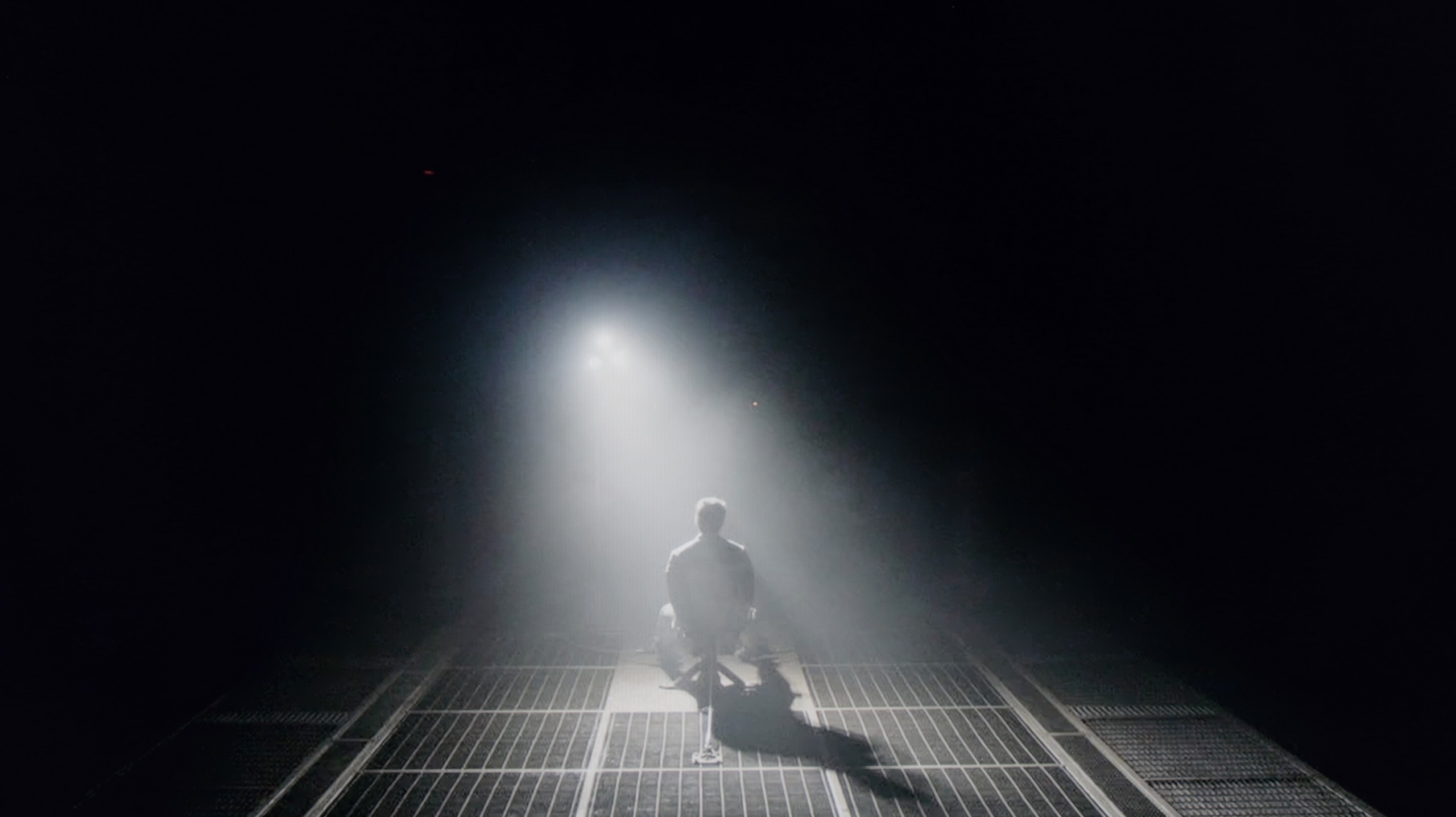
Philips PML9009 is equipped with a high-contrast VA panel. Although it does not deliver as deep and three-dimensional an image as OLED televisions, it is still a much better solution for home cinema compared to IPS/ADS panels. The measured static contrast (without local dimming activated), which stands at 6000:1, can be considered very good and allows for the full potential of the Mini LED backlighting that has been implemented in the tested television. The results of the contrast and black measurements, as you can see for yourselves, are not among the highest, and the only scene where the television demonstrated satisfactory results was that from the film "Oblivion," where the unit can be commended for its light separation, which is not so obvious even in much more expensive units. We should also mention that all tests were conducted at medium dimming power, as the lowest option produced unsatisfactory black levels, while the highest lost a significant amount of detail. Unfortunately, our standard testing procedure with the film "Sicario 2" did not go very well. Yes, all the details in the background are very well visible, but due to the operation of the dimming zones, the overall tone was significantly thrown off, not to mention the strong halo effect around the bright elements of the helicopter.
The Philips PUS8560 in the size we tested is equipped with a VA panel. As a result, black levels – as far as LCD televisions go – can be deemed decent. And that is exactly the case with this model. Both black levels and the overall impression of contrast in the film scenes we tested were really quite good – the image does not bleed, and details are visible even in challenging sections.
But the panel alone is not everything. Unfortunately, the PUS8500 does not come with local dimming (which is a given considering the television segment), so one must be aware that in completely dark conditions, the black can resemble shades of navy more than true black. On the other hand – and here’s a plus for Philips – the Ambilight system does an excellent job. The backlighting genuinely affects the perception of contrast. Therefore, even if technically the black is not perfect, subjectively the viewing experience becomes much more pleasurable. For many people, this is enough to make an evening screening truly impressive.
HDR effect quality
6.1/10
4.8/10
Luminance measurements in HDR:

Result
548 nit

Result
550 nit

Result
824 nit

Result
491 nit

Result
582 nit

Result
273 nit

Result
300 nit

Result
324 nit

Result
343 nit

Result
334 nit
Scene from the movie “Pan” (about 2800 nits)


Scene from the movie “Billy Lynn” (about 1100 nits)


Static HDR10


Dynamic: Dolby Vision
Dynamic: HDR10+


HDR luminance chart:
Philips PUS8500
HDR luminance
Philips PML9009 / 9019 / 9059
HDR luminance
Philips PML9009 does not really operate at the highest values in HDR content. Most effects with brightness at around 550 nits will not leave us thrilled with the lighting effects, although they are quite stable, which is a plus and will make a considerable difference compared to SDR content. It is worth noting that we can only achieve a good result in one scenario, namely in the film "Gemini", where the flashlight as the only light source can shine. Why in that scene specifically? The answer is quite simple. The scene itself does not contain a large amount of black, and the flashlight is not as large an object as the sun in the first and last scenes. Overall, the brightness measurement results in HDR content do not provide a basis for recommending this television for viewing productions that utilise a wide colour spectrum. Although it is worth noting that this model can cover it to a decent extent of 93% in the case of the DCI-P3 palette.
When it comes to the HDR effect on the PUS8560, it can fairly confidently be stated that it is very average. The panel brightness is around 350 nits, which we consider to be the absolute minimum for watching content in this format. However, this is not a result that will astonish a viewer searching for the best possible picture.
On the plus side, it is worth noting that the PUS8500 series – including the PUS8560/12 we tested – is advertised as a QLED television. And indeed, we can expect a wider colour spectrum here. This model is equipped with an additional filter (PFS), and a DCI-P3 colour coverage of around 90% should suffice for the majority of users. This filter works very similarly to quantum dots. As a result, the colours are quite well saturated. It is not an outstanding result, but it is entirely sufficient for watching films and series from streaming platforms.
Factory color reproduction
5.3/10
6.2/10


Factory Mode
After calibration
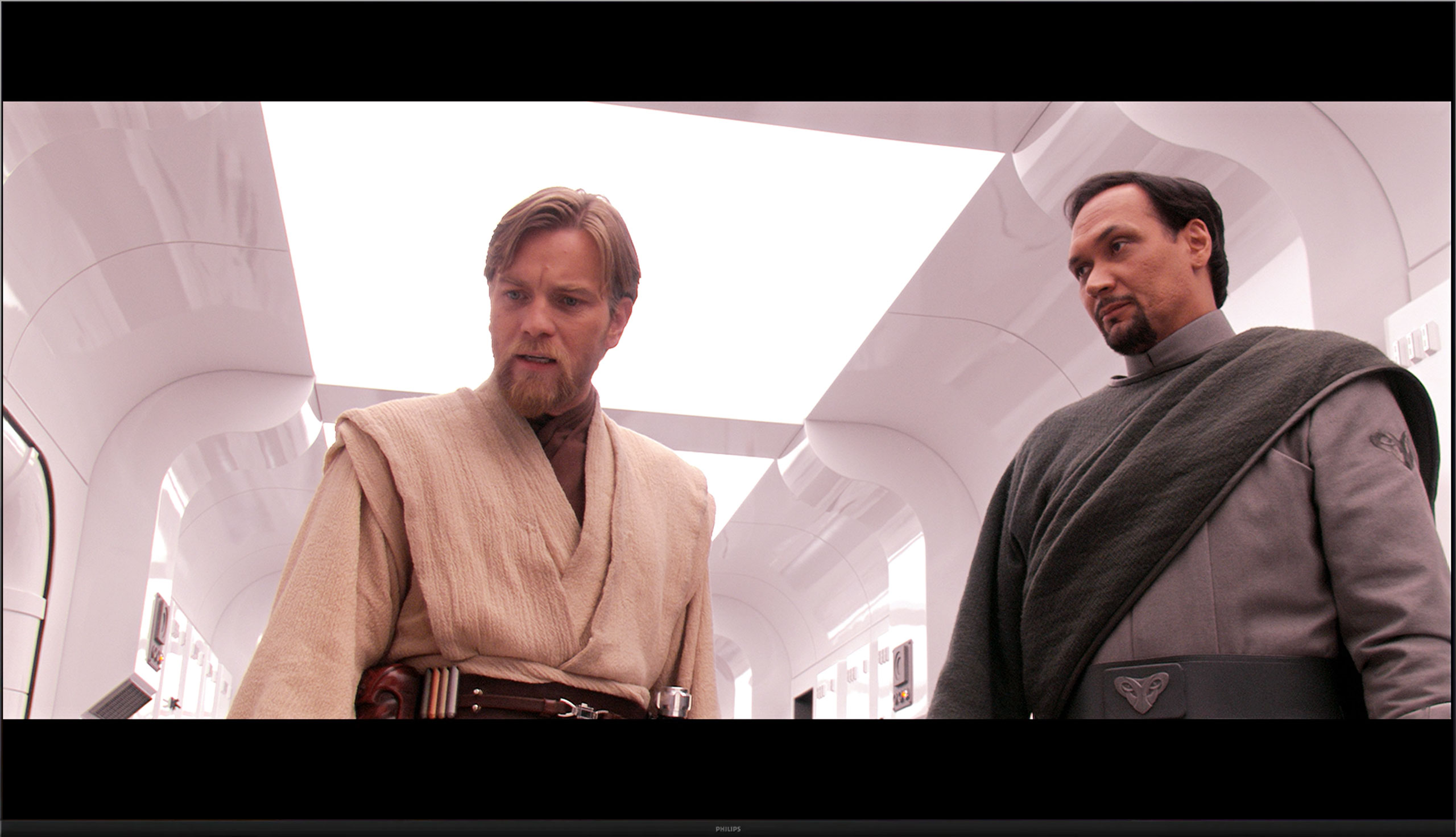
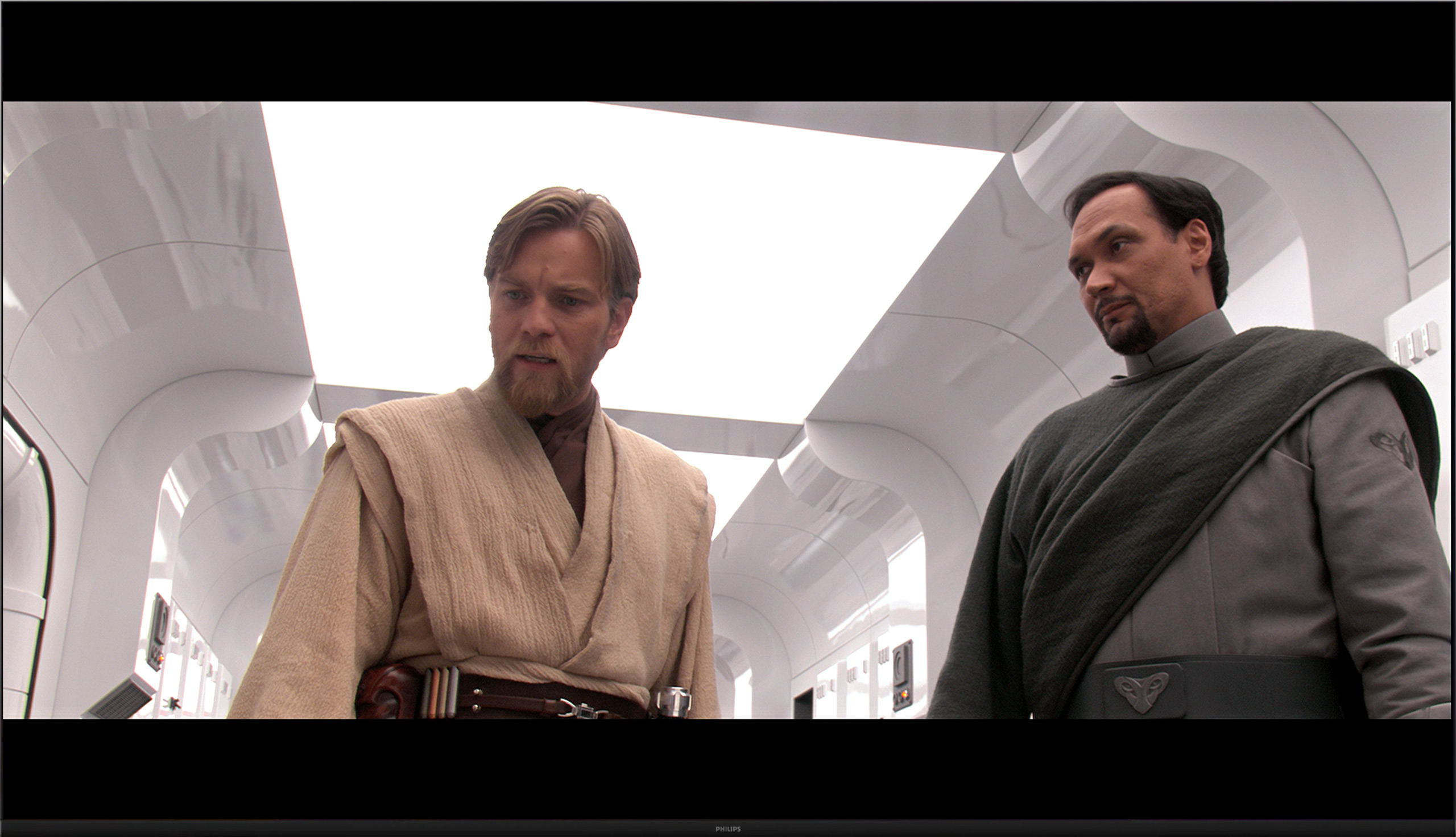
Factory Mode
After calibration
The best factory mode used during our tests was "Filmmaker". Here, we will look at both SDR and HDR content. The element that distinguishes them is primarily the EOTF curve in materials with a wide colour gamut and the gamma in those recorded "the old way". Starting with SDR films and series and the most basic thing we can observe, which is white balance, we see a significant dominance of red colour. This led to a yellow tint across the entire image, causing unnaturally looking faces and yellowed whites. This flaw is also evident on the "ColourChecker" palette, where all colours have shifted towards their warmer counterparts. Looking at a more significant graph, that of the gamma responsible for image contrast, we see considerable errors starting from the very beginning. From the left, the value we measured, marked by a connected ellipsis, clearly spiked upwards, causing complete merging of details in the darkest scenes. This state of affairs remained until 10% screen brightness, after which it dipped below the reference orange line, leading to a deterioration in contrast, which, as we know, the Philips PML9009 already lacks. In HDR materials, the white balance issues were very similar to those in SDR content. The discrepancy arises when checking the EOTF curve, which controls the rate of brightness increase and severely limited it, causing the image to appear unnaturally dark. As for the colours themselves, there were more reasons for concern here, as the television's too low luminance caused a huge discrepancy between the actual state and the correct one, which is perfectly visible on the error graph, often exceeding the scale.
We tested the television with the best available factory settings, namely in Film/Filmmaker mode – this is the mode we recommend for everyday viewing. Unfortunately, it is not without its flaws. Both in HD and HDR content, the image had a noticeable tendency to a pink tint, caused by an excessive amount of red and blue in the white balance. Another issue turned out to be excessive brightness in the image, which was confirmed by both the gamma chart and the EOTF curve. This feature was responsible for loss of detail and washed-out colours in more challenging HDR scenes that we mentioned earlier. The overall result led to significant colour reproduction errors – in extreme cases, the delta E value exceeded 7, while the threshold for visible errors for the human eye is around 3. This situation can be improved with calibration, and you can read about its effects below.
Color reproduction after calibration
7.5/10
8.4/10




Philips PML9009, like most leading manufacturers, has been offering advanced tools for the calibration process for years. Thus, we find 2- and 20-point greyscale adjustment as well as an advanced CMS (Colour Management System). The differences resulting from calibration are evident, and even someone not paying attention to picture quality (although there probably aren't many such here) will notice a positive difference. Both SDR and HDR materials have undergone a significant transformation. The former, as well as the latter, have primarily rid themselves of the unpleasant yellow tint resulting from a red colour dominance in white balance. As for the SDR materials and gamma, although it is not 'lined up' perfectly and still loses dark details, the rest of it is on a more than decent level, and minor errors will not be noticeable. The colours themselves look infinitely better, and thanks to low deltaE errors, they are nearly reference-quality. On the other hand, the HDR materials, due to the low luminance of the unit, were not blended as we would have liked. Although the white balance has been largely normalised, here and there one can notice a slight blue tint. Fortunately, the EOTF curve turned out to be much more accessible and allowed for practically ideal geometry. Unfortunately, due to the screen's insufficient brightness, colour errors are still quite high.
The Dutch manufacturer offers quite a sizable amount of settings in its products, so as usual, we decided to tinker with them a bit. The effects are immediately noticeable – we managed to correct the white balance, which made the image stop appearing excessively pink. The brightness characteristic has also been partially evened out, of course, within the limits set by the television itself. The image is no longer overly exaggerated, and the overall reception after calibration is definitely better than in the factory settings of the Filmmaker mode.
One could only critique the EOTF curve characteristic, which still indicates that the image has a tendency to brighten HDR materials. Despite our efforts, the darkest parts of scenes are still sometimes too bright, and the brightest ones do not always achieve their full contrast potential. However, it must be clearly stated that we are dealing with a typically budget construction – one cannot expect reference-level reproduction of HDR content from it.
Calibration has definitely helped this model – it improved the balance, toned down the aggressive colour palette, and brought the image closer to what one might expect from a well-configured movie mode. However, there are certain limitations that cannot be overcome.
Smoothness of tonal transitions
7/10
6.3/10





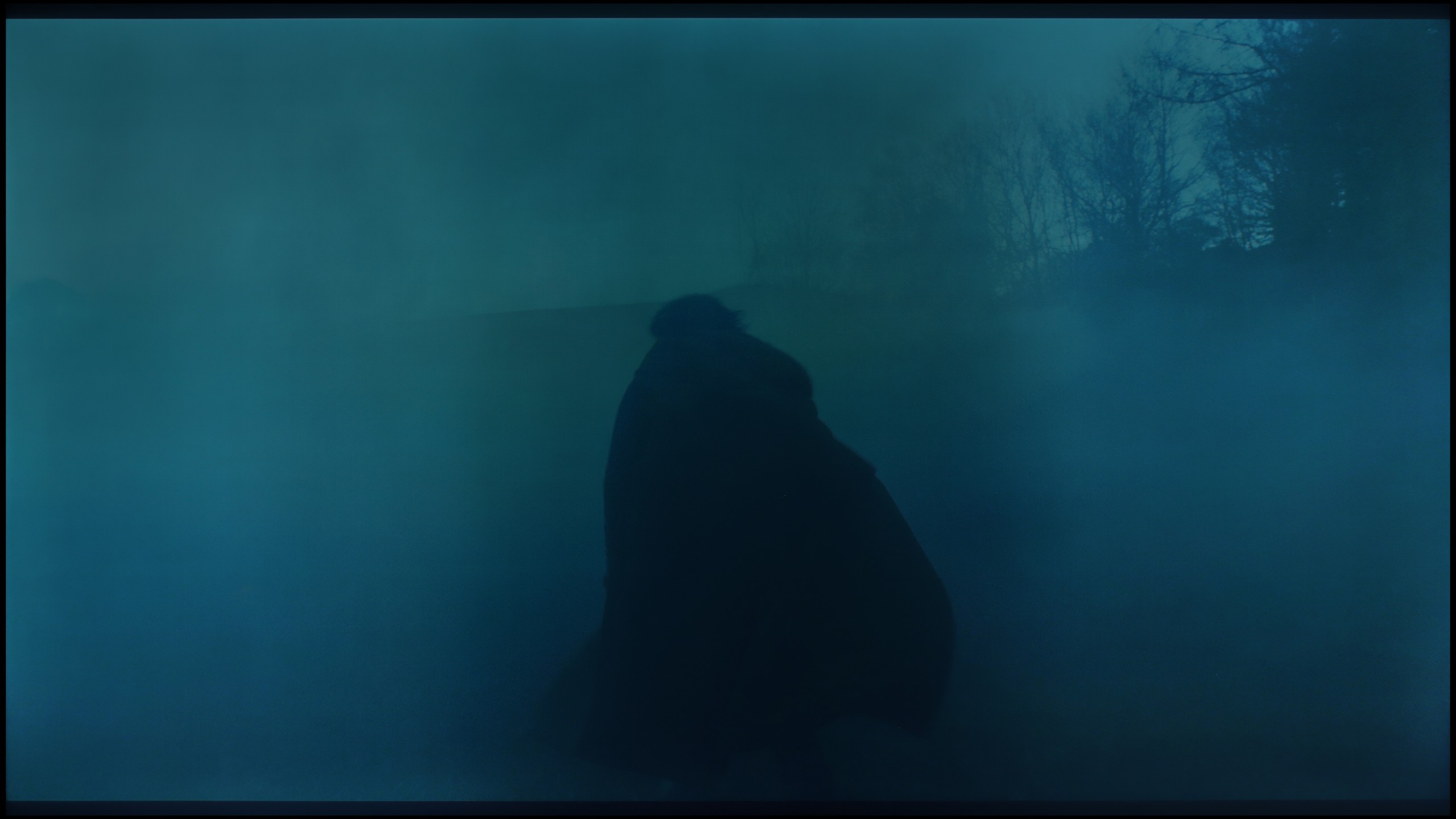

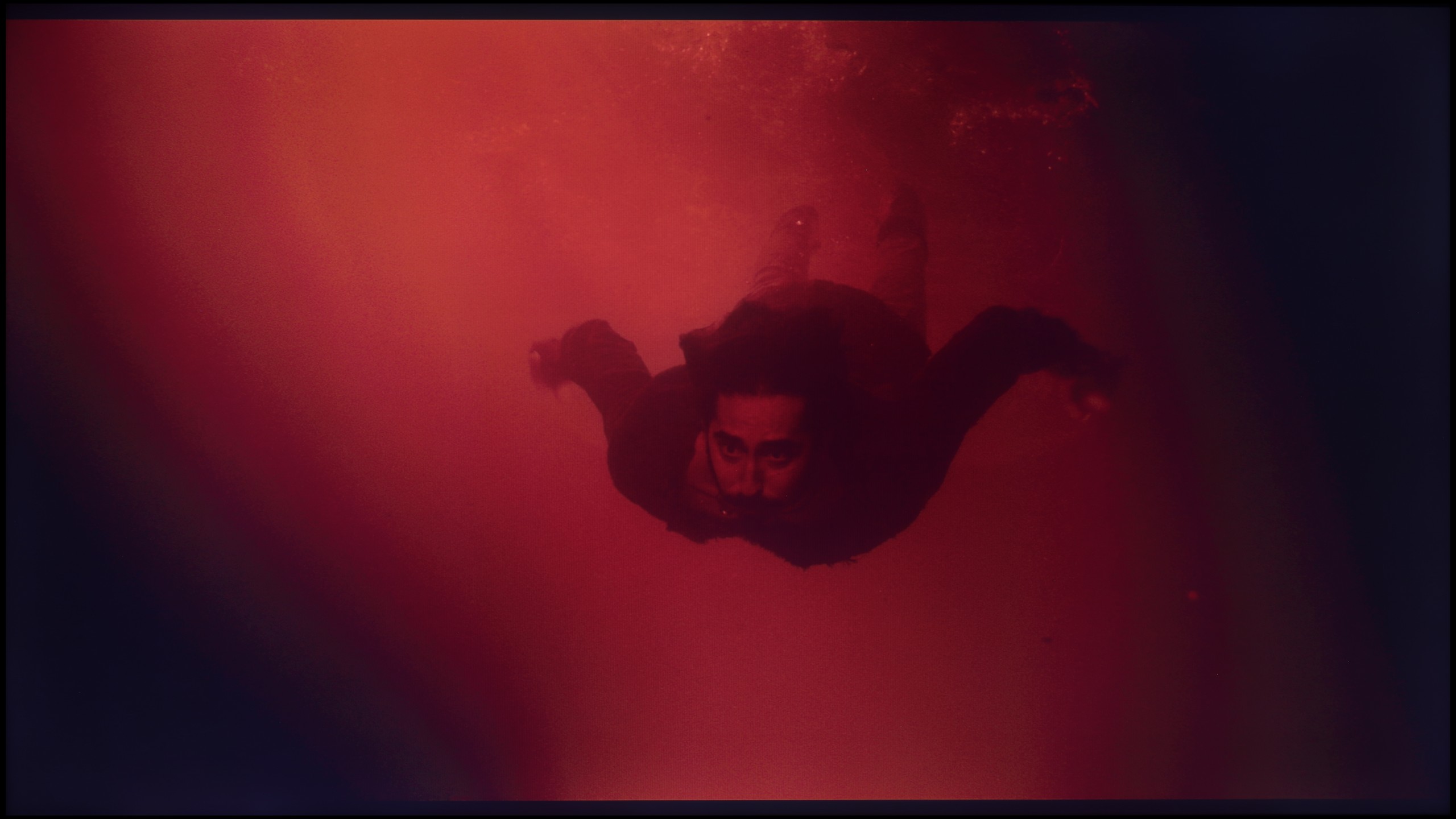




Undoubtedly, many of you have watched a film or series in which there were bands that should have been a smooth transition between colours. Therefore, during our tests, we also pay attention to tonal transitions. Philips PML9009 handled this matter quite correctly with each of the scenes we prepared, and although there are signs here and there of elements that could have been processed better, it is still good. It is particularly worth noting the one from "The Green Knight", which is definitely the most challenging. For the tested television, it did not prove to be a "killer" and there are no significant undesirable stutters visible in it.
The PUS8560 handles colour transitions into smooth gradients very well. During tests, the image appeared coherent and natural, and serious issues with tonal transitions occurred only in very dark scenes – for example, in a shot with red water, where subtle cuts between colours could be noticed. However, these are rather exceptions that do not spoil the reception of most content. It is worth mentioning another phenomenon that more significantly affects the quality of the image – the so-called dithering, which refers to a slight "tingling" visible on uniform backgrounds. This effect can be particularly noticeable in high-quality materials and can somewhat spoil the impression of image clarity. It is for this flaw that we deducted some points in our evaluation.
Image scaling and smoothness of tonal transitions
7.2/10
6.1/10
Smooth transition function

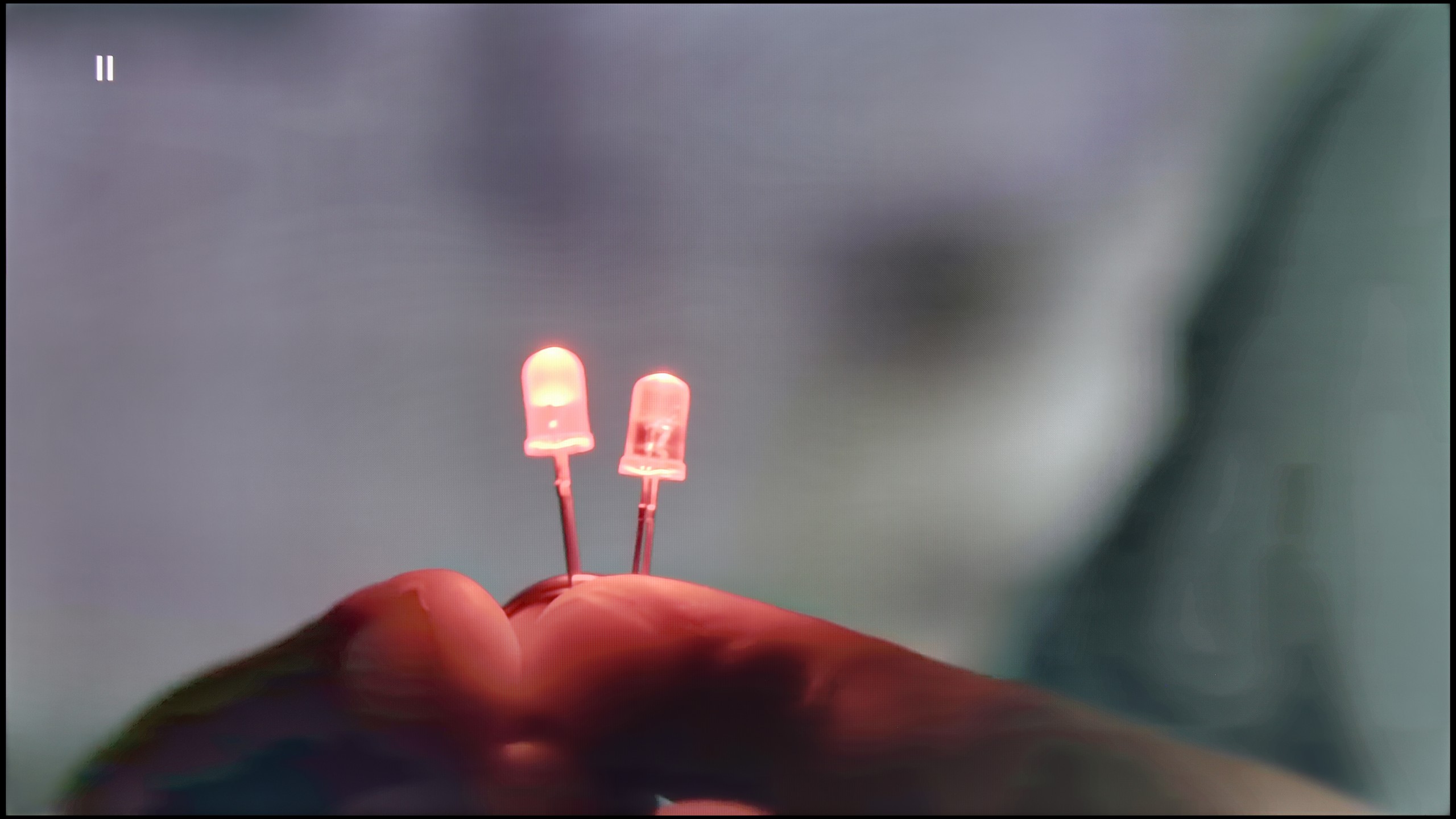
Image without overscan on the SD signal


Judging by how PML9009 Philips handled tonal transitions, the image scaling test should perform equally well. This time we are examining the television's algorithms responsible for enhancing the quality of images that have been recorded in lower quality. Such images can be found in various television programmes or older films. In this regard, Philips PML9009 performs quite mediocrely and significantly blurs the image. This is particularly evident in fine branches or the model's hair.
We will take another look at the tonal transitions, which performed remarkably. Within the unit, we find several levels of smoothing. Even the lowest setting can effectively eliminate any non-fluid tonal transition and will work well with the vast majority of content. More importantly, none of the settings for this function softens the effect of film grain, which is extremely important in terms of alignment with the director's vision. However, we note that sometimes it may turn out that fine details will be blurred.
Philips PUS8560 offers a function for reducing posterization, hidden under the name "distortion reduction". And although it indeed fulfills its role by smoothing out problematic tonal transitions, it works a bit too broadly. In practice, it affects not only colourful gradients but also softens faces, the textures of clothing, and the surfaces of furniture. This compromises the authenticity of the image – especially in films where natural texture is very important. However, if someone is looking for smoothing at all costs, it's best to set this option to "Low". For cinema image enthusiasts – we definitely do not recommend it.
On the positive side, the quality of upscaling older materials is noteworthy – the PUS8560 model handles them surprisingly well. The image retains its natural softness, without artificially boosted sharpness. It is also worth mentioning that the television correctly displays content with very low resolution, avoiding issues with image edge cutting (so-called overscan).
Blur and motion smoothness
7.7/10
4/10


Blur (native resolution, maximum refresh rate):






Philips PML9009 is equipped with a panel that has a native refresh rate of 120 Hz. This is the essential minimum for watching all kinds of sports and is recommended for comfortable gaming in favourite titles on consoles or PCs. The manufacturer has prepared an effective system for improving the sharpness of moving images for those who do not like the characteristic stuttering of footage recorded at 24 fps or require a high level of motion fluidity, for example, when watching football matches. In the dedicated tab, we find the "Fluidity" slider, which helps eliminate stuttering, and "Motion Blur Reduction," which aids in increasing the sharpness of dynamic elements. This function works very well and granularly, meaning each setting has a real impact on the perception of motion. With such a set, every user will find their sweet spot. In the picture, we present our choice, which is a slight fluidity enhancement without the soap opera effect.
A matter directly related to motion is the pixel response time of the panel itself. The best in this regard are, of course, OLED panels, followed by IPS and ADS-based units, and finally, VA. Despite the overall good quality of the systems responsible for smoothing the image, the use of a VA panel carries consequences in the form of a black halo behind fast-moving objects. While this will not occur frequently in the tested television, it will be visible here and there.
The Philips PUS8560 is a television equipped with a panel featuring a refresh rate of 60 Hz, which immediately limits its capabilities in terms of displaying dynamic content. Watching sports or playing on a console is not particularly enjoyable. The situation is further worsened by the lack of any option to improve the smoothness of films. In the menu, we won't find settings that would allow us to enable a motion smoother or even a slight motion smoothing for films recorded at 24 frames per second. You can imagine the effect. The image can appear jerky, especially in shots with panoramic camera movements.
Console compatibility and gaming features
9.8/10
4.7/10
- ALLM
- VRR
- VRR range48 - 144Hz48 - 60Hz
- Dolby Vision Game Mode
- Correct implementation of HGIG
- 1080p@120Hz
- 1440p@120Hz
- 4K@120Hz
- Game bar

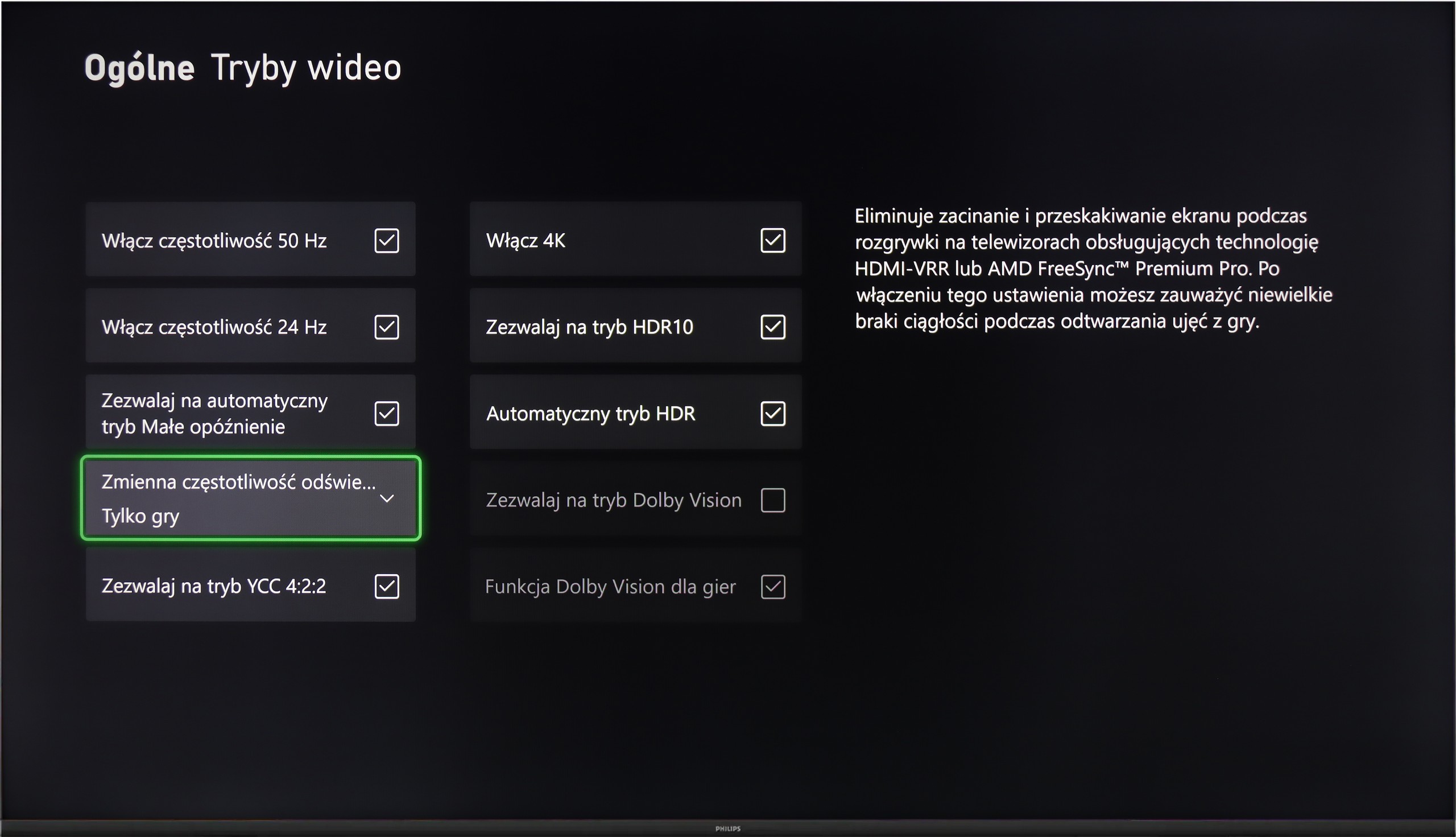

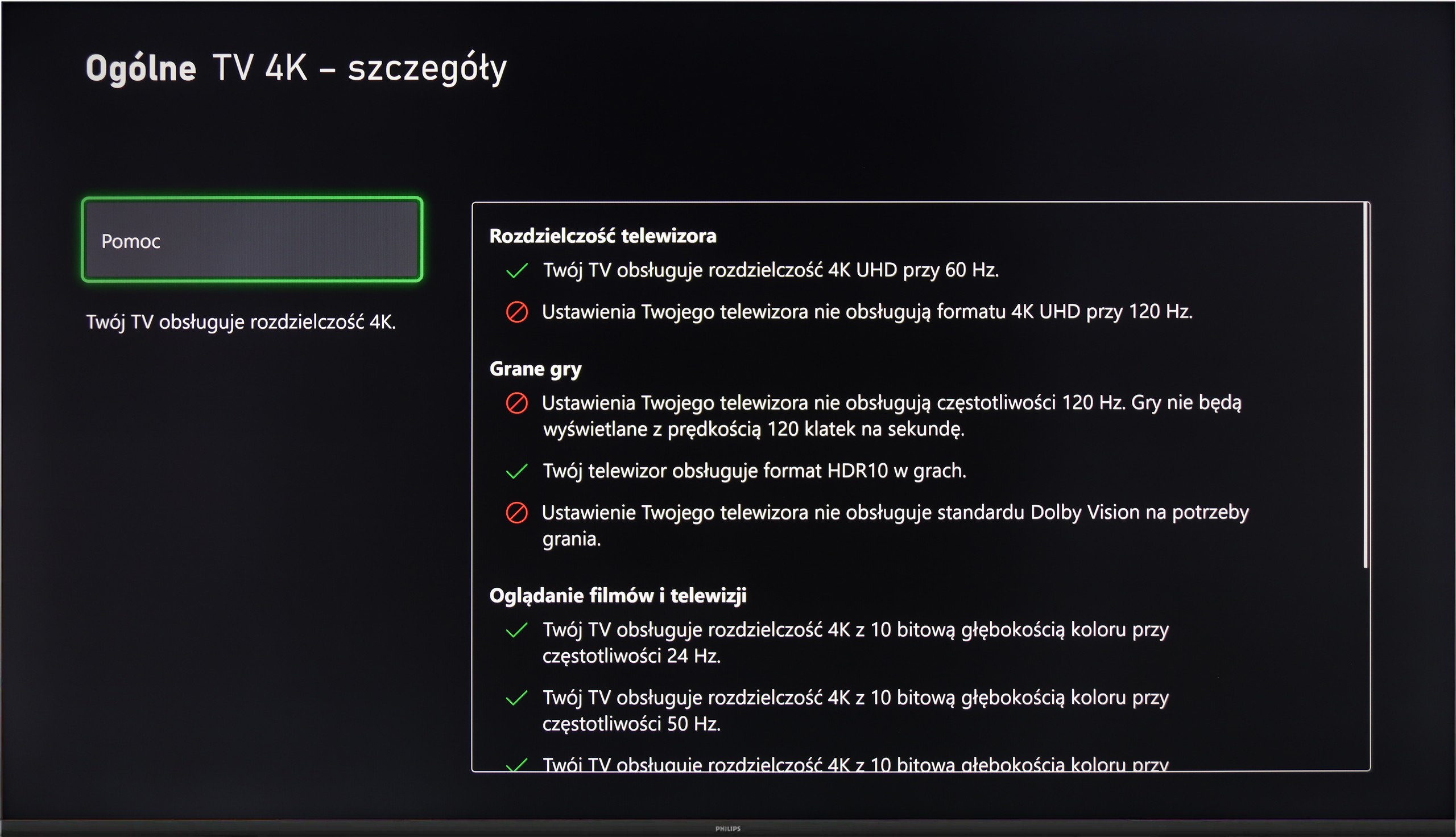

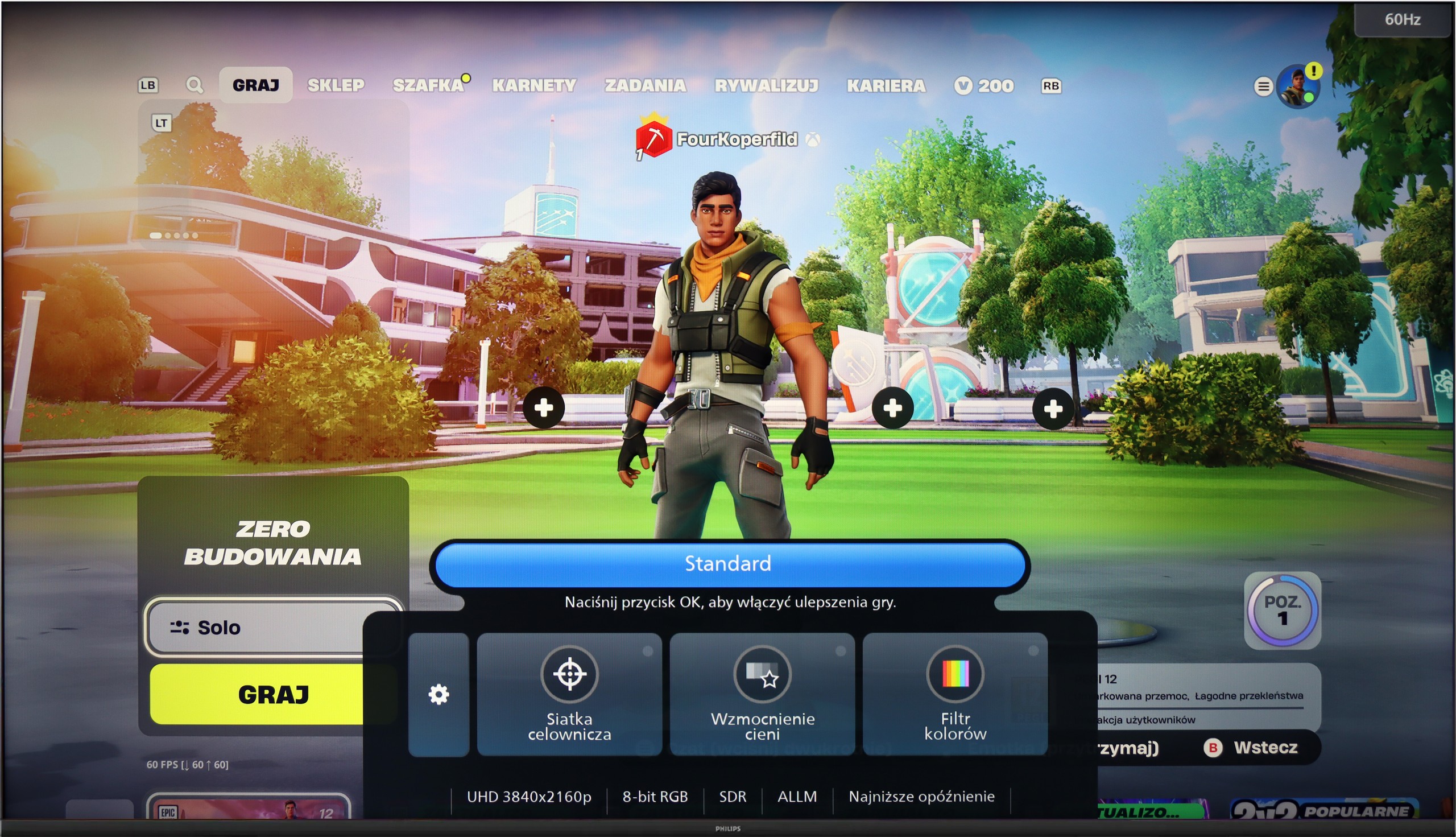

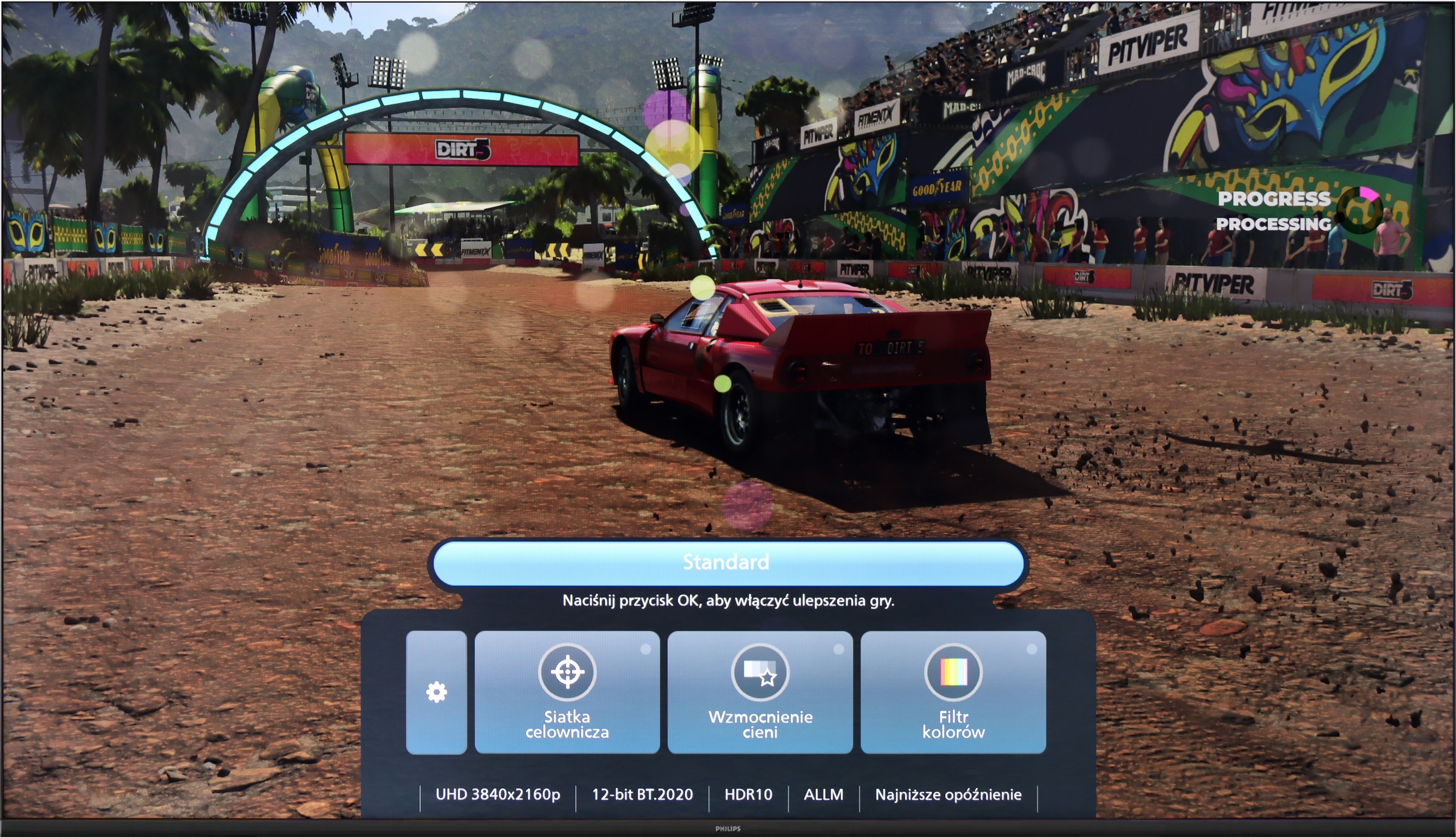
Philips PML9009, equipped with HDMI 2.1 ports at full bandwidth, supports all features dedicated to gamers. The most basic ones, such as VRR and ALLM, are a given, but G-Sync, FreeSync, and gaming in HDR Dolby Vision with low input lag are not. These features activate without any issues and during the tests conducted, they did not present any problems. Such preparation of the television is certainly a strong point and one can say that it is a unit dedicated to gamers. For more advanced users, we also mention that the PML9009 is equipped with an HGIG mode, which will be particularly felt by gamers, as there are still relatively few games supporting Dolby Vision. This mode primarily allows for the adjustment of HDR effects to the capabilities of the television on a special board, in order to avoid dimming or burning out the image.
The television additionally features a special menu - GameBar. This allows for editing the unit's settings "on the fly", without the need to exit the game. We will also find features such as enabling a crosshair or adjusting black levels for better visibility of opponents in shadows.
In a brief summary of this paragraph, the Philips PML9009 is a unit that will certainly capture the attention of gamers. Thanks to its versatility, it will allow playing any title in the highest quality without compromises. Especially since features such as VRR, ALLM, G-Sync, FreeSync, or gameplay in HDR Dolby Vision will enhance the immersion in the favourite title.
Although the Philips PUS8560 is not designed with gamers in mind, the manufacturer has decided to equip it with a few features that may prove useful when connecting a console. On board, we find automatic switching to game mode (ALLM), as well as a simple connection status information bar – the so-called Game Bar. It does not make a particularly strong visual impression, but it serves its purpose. The presence of variable refresh rate (VRR), operating in the range of 48 to 60 Hz, may come as a surprise. While this is not a wide range, in the case of less demanding games or titles with unstable frame rates, VRR can help reduce screen tearing. However, this is the only element that could be considered beyond the minimum.
It must be made clear that the PUS8560 is not equipment for gamers looking for a responsive screen and full support for modern console features. It lacks HDMI 2.1 ports, the refresh rate is limited to 60 Hz, and the response time of the panel is not among the fastest. This model may be suitable at most for casual gamers who want to enjoy the Ambilight system.
Input lag
9.6/10
10/10
SDR
HDR
Dolby Vision
The results of input lag measurements in Philips PML9009 are at a high level, regardless of the signal or resolution. All gamers will surely appreciate the manufacturer's efforts, as a game running at 4K120Hz with HDR has only 8 ms of latency, which is virtually unnoticeable even in online games. It is also worth mentioning the proper implementation of the gaming mode with Dolby Vision, which can be praised for a similar response time at 16 ms.
The input lag on the PUS8560 is very good. When we previously mentioned that this screen is rather for the "casual gamer," there is nothing to be ashamed of in this regard – even when compared to screens aimed at gamers. Results around 12 ms are truly outstanding, allowing for an enjoyable responsive gameplay experience. It doesn't matter whether we are playing in Full HD or 4K – the lag remains equally low, so if you value a quick response time, the PUS8560 will definitely not disappoint in this aspect.
Compatibility with PC
8.6/10
5.6/10

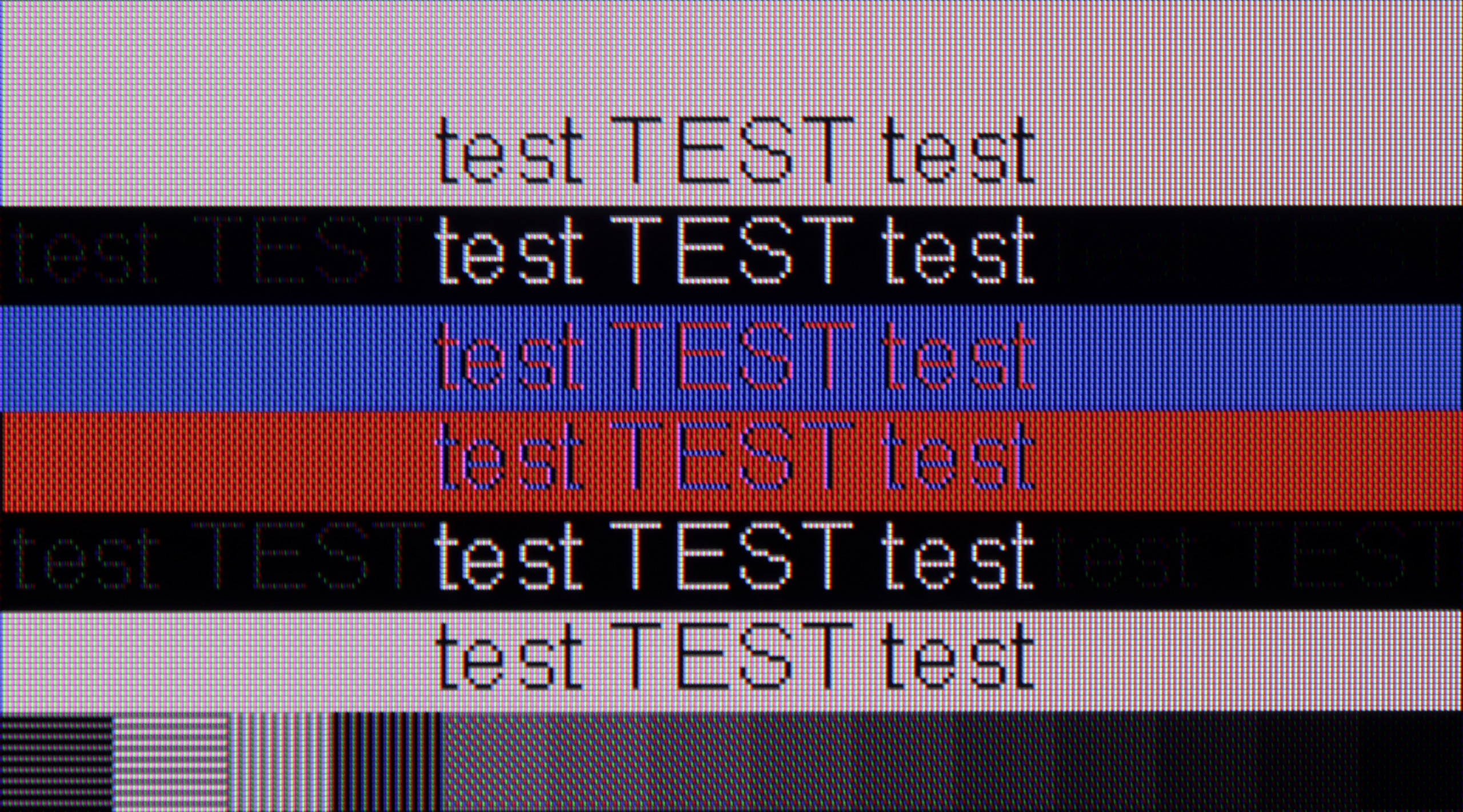
Just like in games, the tested Philips PML9009 performs excellently in daily tasks as well. Measured latency of 8 ms allows for virtually instantaneous response on the mouse-screen-eye line. The correct implementation of chroma 4:4:4 enables work with text without any issues thanks to sharp fonts. The subpixel arrangement of the matrix is BGR; however, this does not cause any discomfort when working on the Windows system. It may be different with other systems that might not be able to correctly convert the text.
When it comes to working with a PC on the PUS8560, it looks... quite strange. Chroma 4:4:4 is present in "Monitor" mode, but there is a problem with grey fonts – not all subpixels are lit, which results in the text appearing jagged. On the other hand, in "Game" mode – chroma 4:4:4 disappears, but the grey fonts look correct. In practice, we are therefore forced to juggle settings if we want to have perfectly readable text at all times. And what about gaming on the computer? Our opinion remains the same as for consoles – it is doable, but without fireworks. There is no variable refresh rate for G-SYNC graphics cards, and the refresh rate itself remains relatively low. However, we can once again highlight the very low input lag, which saves the situation in dynamic games.
Viewing angles
2.6/10
3.3/10
The commonly known drawback of VA panels that do not have an angle coating is their poor viewing angles. This is no different this time. Even with a slight deviation from the axis, the image becomes washed out, and the colours undergo significant degradation.
The viewing angles on the PUS8560 are precisely what one would expect from a VA panel - it's not the best. The image loses quality even with a slight shift off-axis – colours become washed out and black begins to resemble a dark navy. This is, of course, the price paid for the better contrast that VA offers when viewed directly. In the case of our 55-inch model, this is still acceptable, especially if the television is positioned perfectly opposite the sofa. However, with larger screen sizes or a less central placement in the living room – it could become a problem for comfortable viewing.
TV efficiency during daytime
6.1/10
4.9/10

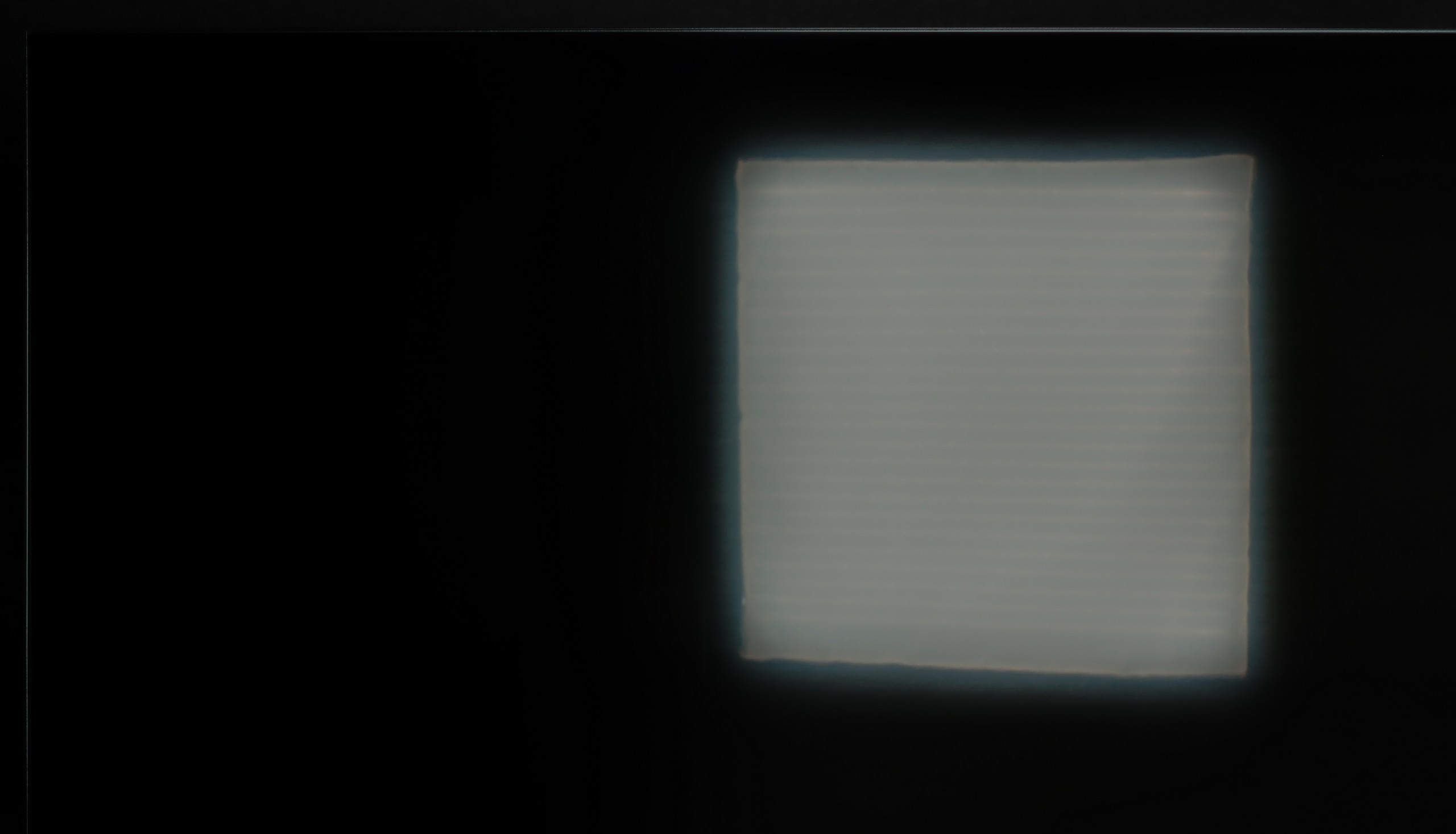


Matrix brightness
Average luminance SDR
Philips PUS8500 : 331 cd/m2
Philips PML9009 / 9019 / 9059: 564 cd/m2
As far as the brightness of the television itself in SDR material is good (let's face it, we watch films in the evening or in the dark), the suppression of reflections is at a rather average level. This is due to the satin finish of the panel, which is quite susceptible to all light sources and neither absorbs nor disperses them. However, it is worth noting that thanks to the fairly high brightness in SDR material, the television performs fairly well in bright rooms overall, and certainly better than a large number of OLED televisions.
The PUS8560 performs moderately during the day. The satin matrix coating quite effectively dampens reflections, which means that light from windows or lamps does not interfere too much. The blacks also look decent for a VA panel – even in daylight, there are no significant losses in contrast. However, all the charm fades when it gets really bright. The panel's brightness is around 300 nits, which is definitely too little to speak of full comfort in a heavily lit room. In such conditions, the PUS8560 simply needs to be aided by blinds – otherwise, the image begins to look rather pale.
Details about the matrix
Subpixel Structure:

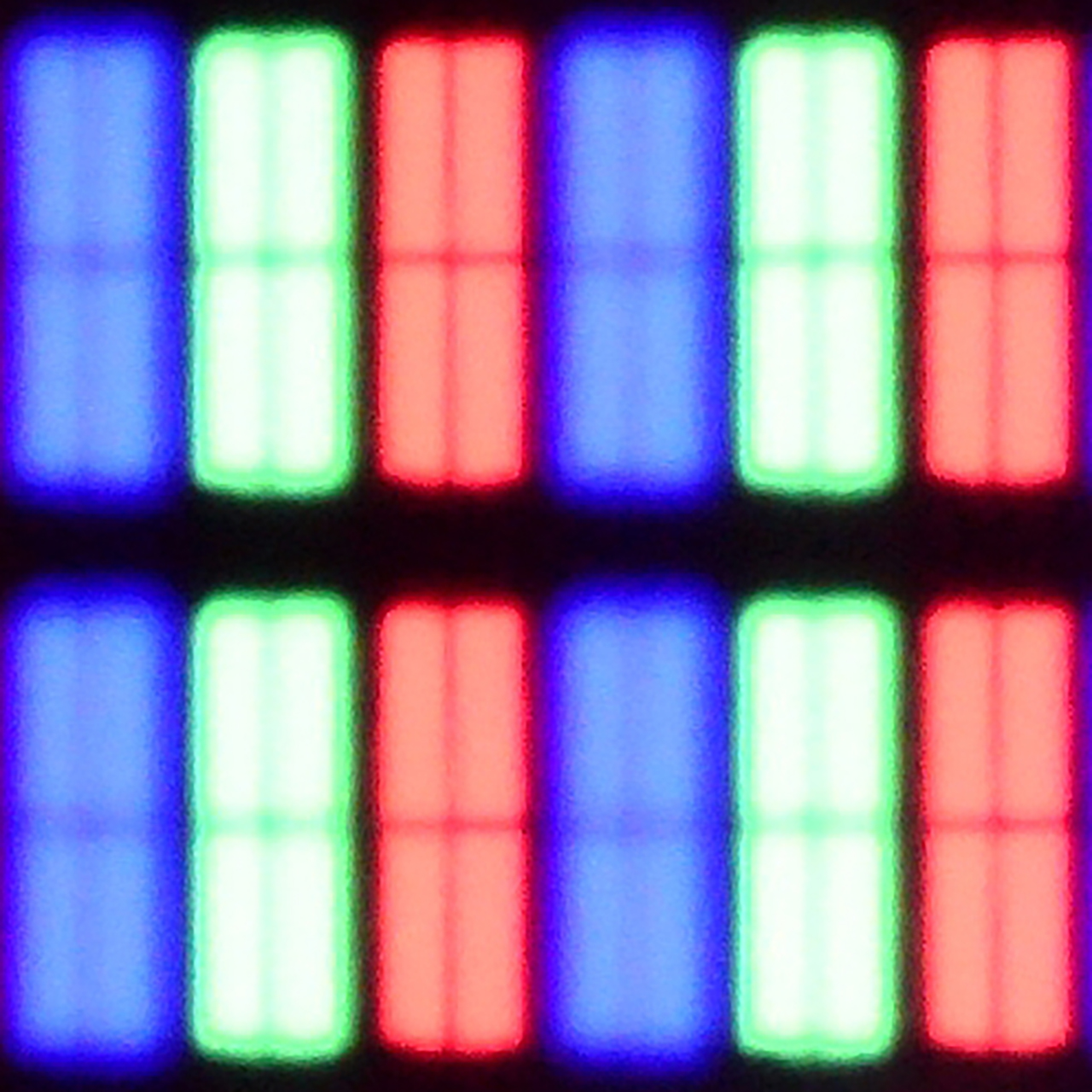
Panel uniformity and thermal imaging:


Philips PML9009 / 9019 / 9059
Philips PUS8500
TV features
6.1/10
4.8/10
- HDMI inputs0 x HDMI 2.0, 4 x HDMI 2.1 48Gbps3 x HDMI 2.0, 0 x HDMI 2.1
- OutputsToslink (Optical audio), eARC (HDMI), ARC (HDMI), Mini-Jack (Headphones)Toslink (Optical audio), eARC (HDMI), ARC (HDMI), Mini-Jack (Headphones)
- Network InterfacesWi-Fi 2.4GHz, Wi-Fi 5GHz, Ethernet (LAN) 100MbpsWi-Fi 2.4GHz, Wi-Fi 5GHz, Ethernet (LAN) 100Mbps
- TV receptionDVB-T, DVB-T2, DVB-S, DVB-S2, DVB-CDVB-T, DVB-T2, DVB-S, DVB-S2, DVB-C
Classic features:
- Recording to USB (terrestrial TV)
- Recording programming
- Picture in Picture (PiP)
- RF remote control (no need to aim at the screen)
- Backlit remote control
- Teletext
- Audio only mode
- Bluetooth headphones support
- Simultaneous Bluetooth headphones & TV audio
Smart features:
- AirPlay
- Screen mirroring (Windows Miracast)
- Voice search
- Voice search in native language
- Ability to connect a keyboard and mouse



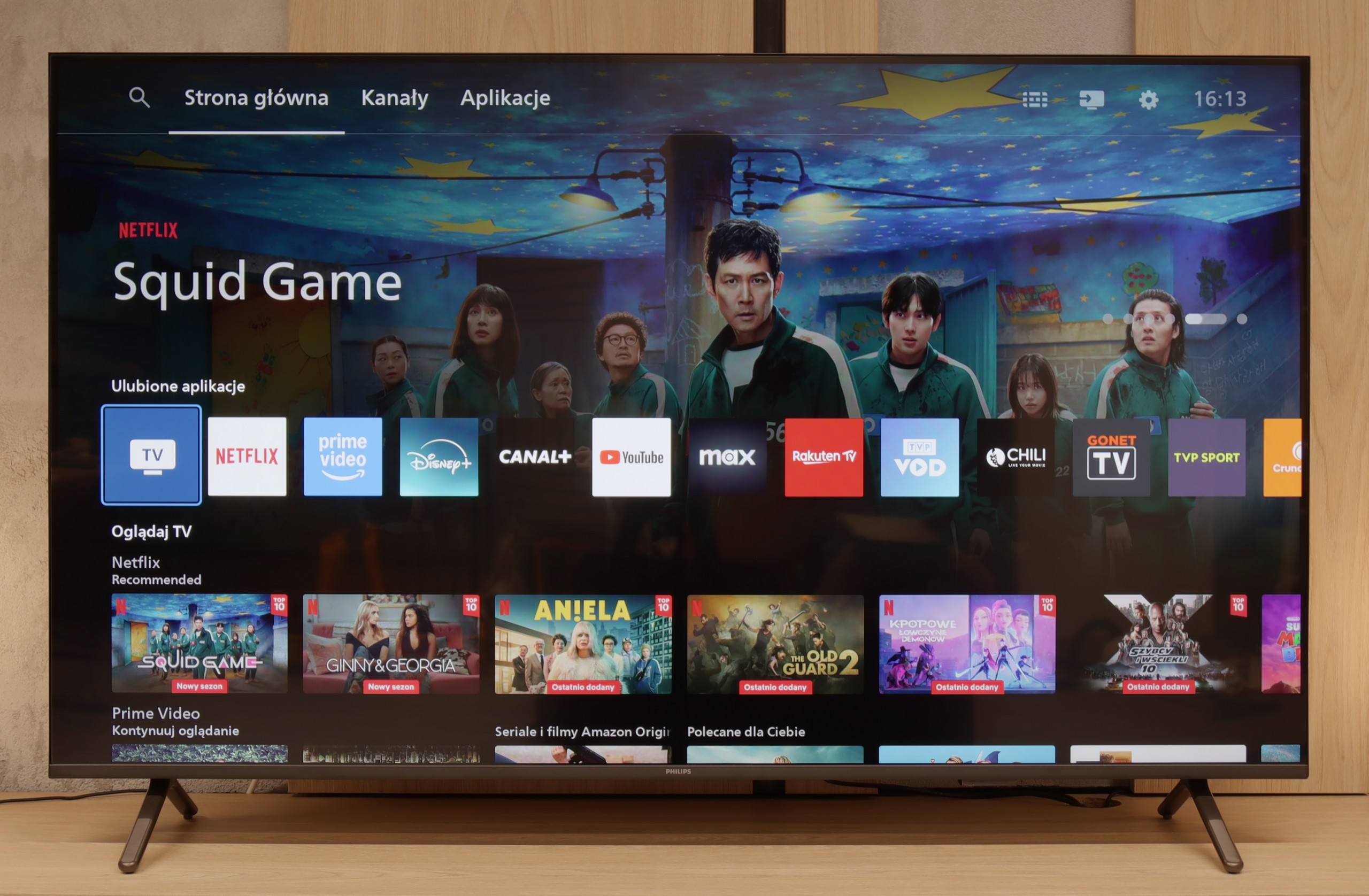
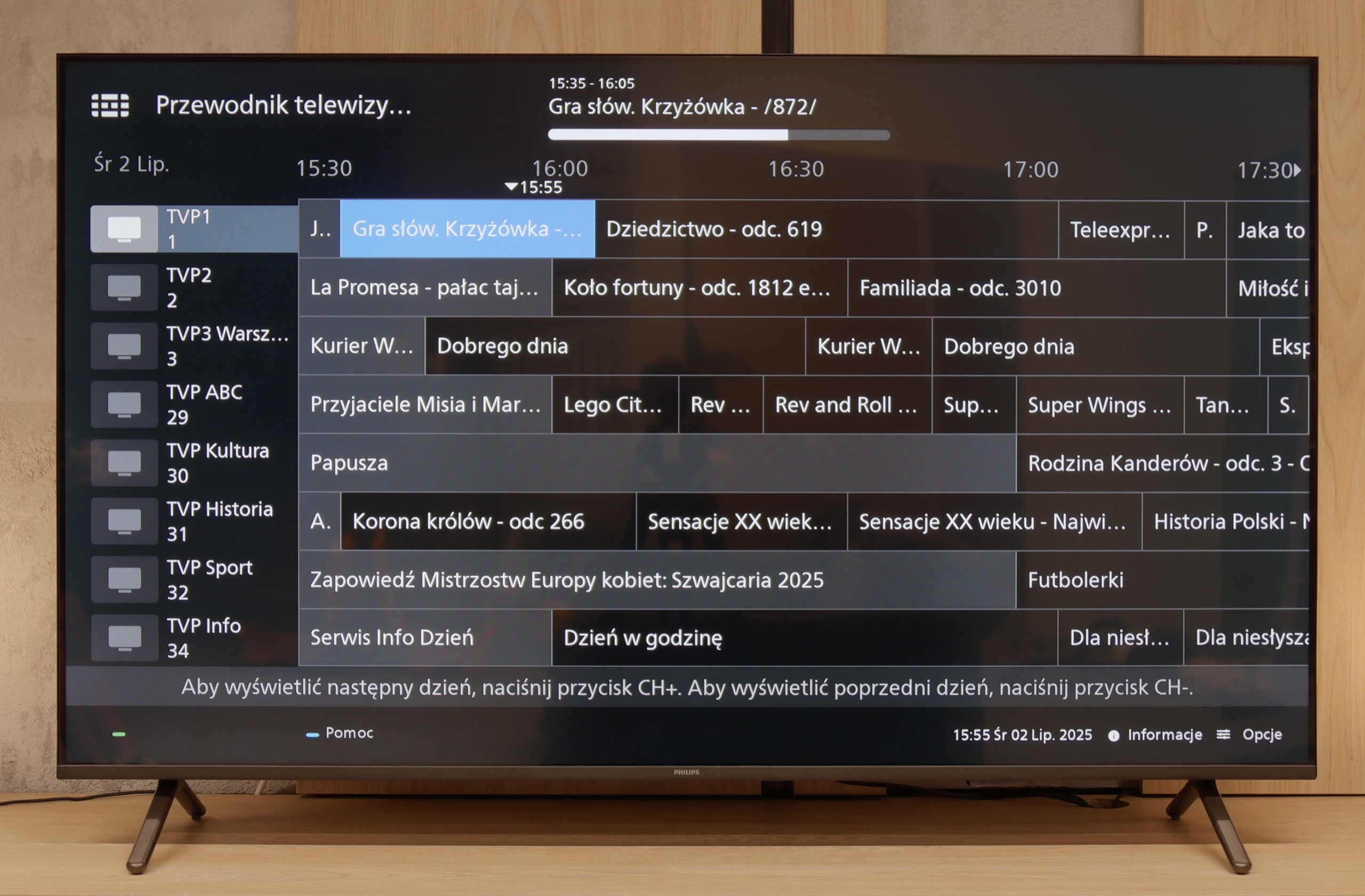
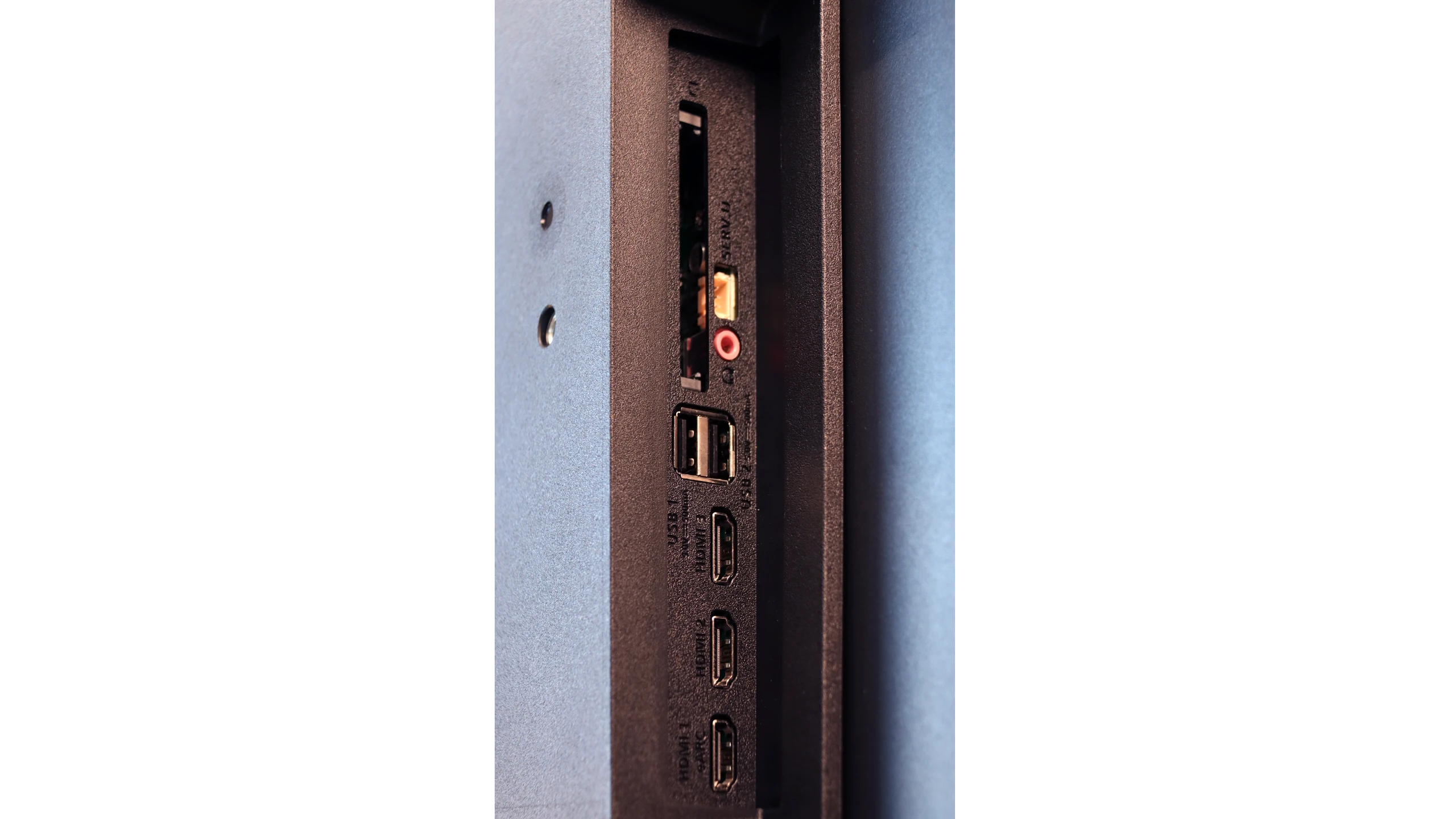
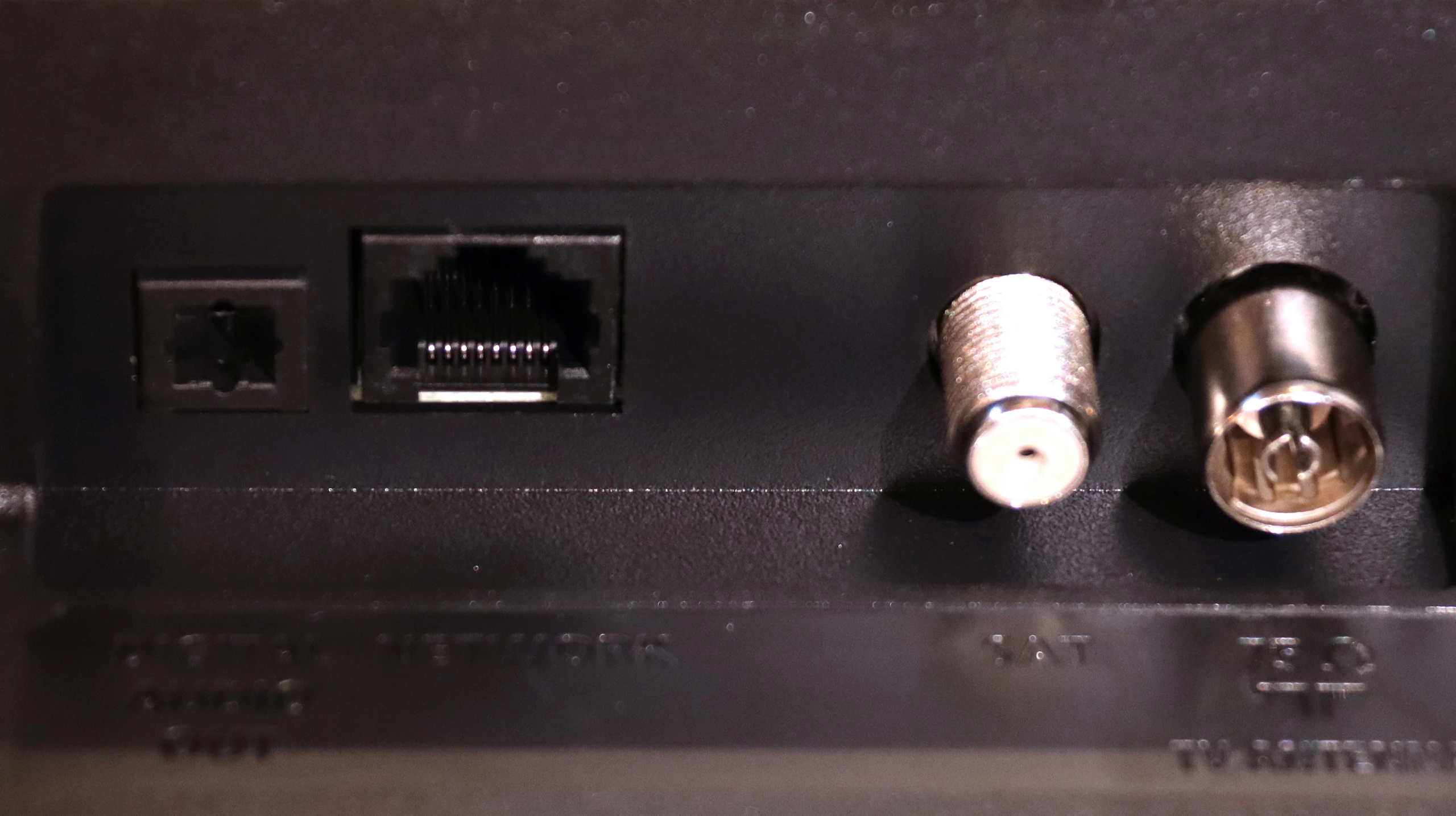
Before we move on to the software that controls the television, it is impossible not to mention the biggest distinguishing feature of the manufacturer's televisions. This is, of course, the multicoloured Ambilight backlighting, which is placed on the back of the device and displays colours tailored to what is happening on the screen, often allowing for an even greater sense of immersion. The operating system responsible for the television's functionality is Philips' proprietary system charmingly named TitanOs. It is definitely more closed and limited in terms of app resources compared to other televisions from the manufacturer that use the GoogleTV system. In addition to a lack of significant applications, its closed nature is also evident in another respect. We will not be able to perform such basic tasks as programming recordings or recording to USB. Those using Apple devices may also feel disappointed by the lack of AirPlay functionality, which allows for easy screen streaming. Fortunately, there is the option to connect a keyboard and mouse for easier navigation through the television menu. It's also worth mentioning that while the remote pairs via BT, it only works for voice selection in English. The rest operates via IR...
In summary: TitanOs has quite a few "buts," especially if we are aware users needing and using many streaming platforms. It is rather an option for those limiting themselves to the so-called holy trinity, which is Netflix, YouTube, and CDA.
Classic TV Features:
If you are looking for a television that "works" in the most basic sense – the PUS8560 will fulfil that role. In terms of classic features, we have a rather minimalist set. On the plus side, there is an electronic programme guide (EPG), teletext, a backlit remote control with a classic numeric keypad, and a headphone jack input. It sounds a bit like a dream set for seniors – and there is some truth to that. However, it must be stated clearly: this is a television with very limited capabilities. We will not find recording functions from DVB tuners to USB here, nor is there a PiP mode or other conveniences known from more expensive models.
Smart TV:
How does the SmartTV perform on the PUS8560? Well, this is where it gets a bit more complicated. The PUS8560 runs on the Titan OS, which in this particular implementation posed significant problems. Some features, although present "on paper," simply did not work. For example: Wireless screen mirroring functions, such as Chromecast or Miracast – we tried to activate them from several different phones and laptops… without success. Perhaps this will be fixed in the future, but at the time of testing – it did not work. Additionally, the system's speed left much to be desired – switching between applications or home screens was simply slow. A considerable portion of the menu functions seems to be well hidden in the depths of a poorly organised system. To make matters worse, the library of available applications is quite limited. Even though the situation with applications is better than last year, it is still far from ideal. The situation tries to be salvaged by a modern remote – slim, elegant, backlit, and really well made. Unfortunately, it operates on classic infrared, so you have to aim it at the screen. The only exception is voice control, which works via Bluetooth… it’s just a pity that it doesn’t support Polish.
Playing files from USB
8.2/10
8/10
Supported photo formats:
Maximum photo resolution:

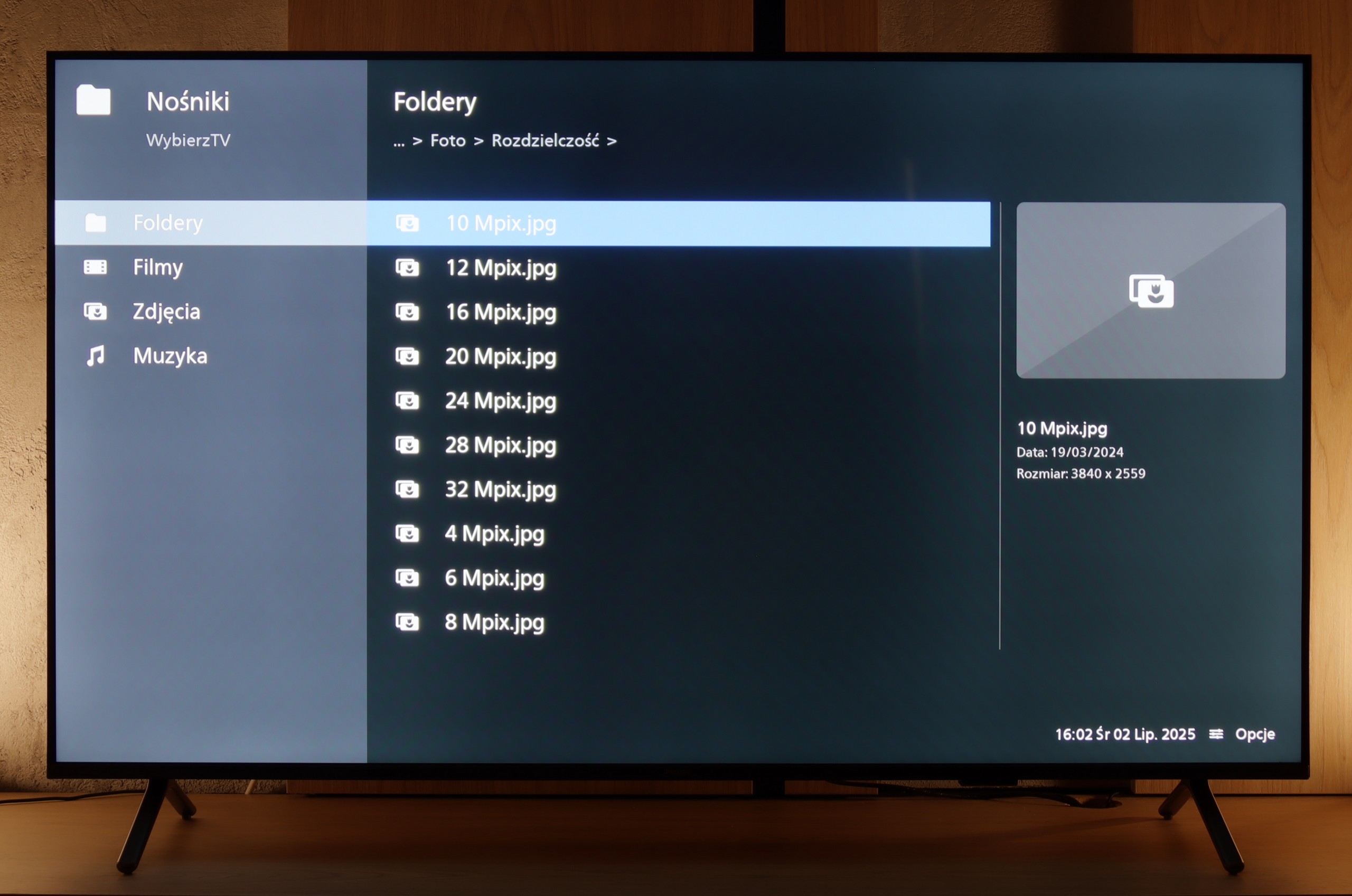
The default media player built into Philips PML9009 offers quite a wide range of capabilities, but it also has its limitations. It plays practically all video formats, except for .asf, which is rather uncommon. However, the issues are the lack of the H.265 HEVC codec at high bitrate and support for .sub files, which are quite popular. When it comes to photos, the player performs adequately, but it lacks support for some common resolutions and formats, such as HEIC, which is used on Apple devices. The player performs best with audio, where it can be faulted in no way. Unfortunately, due to system limitations, there is no possibility to expand its functions, which means we are left with what the manufacturer has prepared.
The PUS8560 handles the playback of most popular video and audio formats from a USB memory stick without any major issues, so there’s no point in detailing the compatibilities one by one. In everyday use, it should simply work – and it does. The only thing worth noting is the handling of images. Although the television easily recognises popular file extensions, there are instances when some images simply do not display when the graphic files have very high resolutions. This may not be a huge problem, but it’s good to keep it in mind, especially if we want to view photographs straight from the camera. Apart from that, the PUS8560 shouldn’t pose any significant issues with playing files from USB.
Apps
6.2/10
4.6/10














































Sound
6.7/10
6.2/10
- Maximum volume--
- Dolby Digital Plus 7.1
- Dolby True HD 7.1
- Dolby Atmos in Dolby Digital Plus (JOC)
- Dolby Atmos in Dolby True HD
- DTS:X in DTS-HD MA
- DTS-HD Master Audio
To begin with, it is worth noting that sound quality is a subjective matter. The built-in audio system in Philips PML9009 stands out for its clear treble, but the bass is rather flat and significantly worse than in competing models in the same price range.
The television sounds quite pleasant and can confidently be regarded as having sufficient sound levels for most users – both for watching everyday programmes and for an evening viewing of a series. Moreover, a pleasant surprise is that even in this budget-friendly series, Philips has chosen to acquire licenses for full audio formats such as Dolby Atmos and DTS. This is great news for owners of home cinemas and soundbars, as it means full compatibility and no need to "fiddle around" with connecting external devices.
